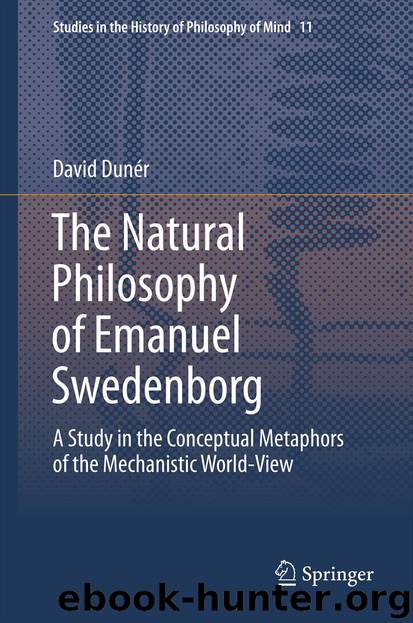The Natural philosophy of Emanuel Swedenborg by David Dunér

Author:David Dunér
Language: eng
Format: epub
Publisher: Springer Netherlands, Dordrecht
A Sea of Bubbles
In January 1718 Swedenborg wrote to Benzelius to tell him that he was working on an essay in which he sought to prove, with the aid of geometry, that air and water particles must be round. It would be good, he thought, if he could have some opinions about it from Roberg, ‘who is himself subtle in all that is minute and subtle’, but the judgement of Johan Vallerius would also be valuable, if he ‘would lay aside a little his own and his father’s Cartesium’. In fact, a portrait of Harald Vallerius shows him resting his arm on a thick book by Descartes, holding a pair of compasses in his hand, prepared to measure the world on a firm foundation. One can thus discern a certain revolt against dogmatic Cartesianism, although Swedenborg’s future theory of matter on the whole does not depart from basic Cartesian principles. His intention was to proceed with this topic in a ‘large book’ as scholars in foreign lands do with their speculations, ‘but since here one has not the facilities for so large a publication, the mouth must adapt itself to the foodsack’. The great utility of the geometrical approach would be that it would be easier to ascertain the nature of air and water. If one knows the geometrical properties of the particles one can also deduce their other properties: ‘for if one finds the correct figure of the particles, one will in turn get to know all the properties which belong to that figure.’121 If one can identify the geometrical forms of particles, then, one can deduce and draw conclusions about their other properties. He hopes that there is a solid foundation for this, since he does not want to publish anything that is not better grounded than what he wrote in the previous issue of Dædalus Hyperboreus about stereometric rules. ‘If the post is to be so atrociously raised, as is talked of, one will likely have to take leave of his friends and relatives’, he writes anxiously and sends the manuscript about small round particles with Rudbeck as courier. I believe it ‘will be well-received abroad’, he says self-consciously, and it is to be dedicated to Abbé Bignon.122
Swedenborg says that he wants to penetrate everything to do with fire and metals. The method is to use chemical experiment and experience, derived from learned men such as Boyle, Becher, Hiärne, and Lémery, in order to search for the smallest constituents of nature which can be compared to geometry and mechanics. Yet it was not necessary to perform experiments of his own, as he wrote to Benzelius in May 1720:It seems to me, that an endless number of experiments is a good foundation to build upon, in order to make use of the labour and expenditure of other men, that is, to work with the head, over that on which others have worked with their hands. From this could come a multitude of deductions in chymicis, metallicis, fire and all their phenomena.
Download
This site does not store any files on its server. We only index and link to content provided by other sites. Please contact the content providers to delete copyright contents if any and email us, we'll remove relevant links or contents immediately.
| Anthropology | Archaeology |
| Philosophy | Politics & Government |
| Social Sciences | Sociology |
| Women's Studies |
The remains of the day by Kazuo Ishiguro(8818)
Tools of Titans by Timothy Ferriss(8215)
Giovanni's Room by James Baldwin(7189)
The Black Swan by Nassim Nicholas Taleb(7010)
Inner Engineering: A Yogi's Guide to Joy by Sadhguru(6724)
The Way of Zen by Alan W. Watts(6505)
Asking the Right Questions: A Guide to Critical Thinking by M. Neil Browne & Stuart M. Keeley(5632)
The Power of Now: A Guide to Spiritual Enlightenment by Eckhart Tolle(5604)
The Six Wives Of Henry VIII (WOMEN IN HISTORY) by Fraser Antonia(5394)
Astrophysics for People in a Hurry by Neil DeGrasse Tyson(5130)
Housekeeping by Marilynne Robinson(4340)
12 Rules for Life by Jordan B. Peterson(4249)
Double Down (Diary of a Wimpy Kid Book 11) by Jeff Kinney(4206)
The Ethical Slut by Janet W. Hardy(4172)
Skin in the Game by Nassim Nicholas Taleb(4161)
Ikigai by Héctor García & Francesc Miralles(4124)
The Art of Happiness by The Dalai Lama(4063)
Skin in the Game: Hidden Asymmetries in Daily Life by Nassim Nicholas Taleb(3929)
Walking by Henry David Thoreau(3892)
